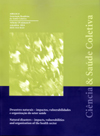1593/2013 - Dental Space Problems in Brazilian Adolescents and Associated Factors
Probelmas de Espaço Dentário em Adolescentes Brasileiros e Fatores Associados
Author:
• THEODORICO DE ALMEIDA NUNES NETO - Nunes Neto, T.A. - BELÉM, PA - CENTRO UNIVERSITÁRIO DO PARÁ - <theo_neto@hotmail.com>Co-author(s):
• Rejane Christine de Sousa Queiroz - QUEIROZ, R.C. de S. - Universidade Federal do Maranhão - UFMA - <queiroz.rejane@gmail.com>ORCID: https://orcid.org/0000-0003-4019-2011
• ERIKA BÁRBARA ABREU FONSECA THOMAZ - Thomaz, E.B.A.F. - SÃO LUÍS, MA - Universidade Federal do Maranhão - UFMA - <ebthomaz@globo.com>
ORCID: https://orcid.org/0000-0003-4156-4067
• Meire Coelho Ferreira - Ferreira, M.C. - Universidade CEUMA - <meirecofe@hotmail.com>
• Alcione Miranda dos Santos - Santos, A.M - Universidade Federal do Maranhão - UFMA - <alcione.miranda@gmail.com>
ORCID: https://orcid.org/0000-0001-9711-0182
Thematic Area:
EpidemiologiaAbstract:
ABSTRACTThe aim of this study were to estimate the prevalence of dental space problems in adolescents and associated factors using data from the survey SB Brazil 2010. The outcome measures were the dental problems of space: space deficit (crowding and misalignment) and excess space (diastema and spacing) obtained by DAI index. The association of independent variables with outcomes was assessed through a hierarchical model with four levels: contextual, socioeconomic and demographic characteristics, access to services and dental morbidity. Statistical analysis was performed using chi-square test (α <0.05), the Poisson distribution uni and multivariate analyzes, estimating prevalence ratios (PR). The overall prevalence of space problems was 71.43%, the misalignment the most common type (56.4%). Were significantly associated with excess of space age of 16, 18 and 19 years, not being white (PR = 1.75), perception of speech problems (PR = 1.72) and periodontal pockets 4-5mm (RP = 1.56). For space deficit: family income up to 3 minimum wages, dental visits for 1 year or more (PR = 1.19) and having an average or more decayed teeth (PR = 1.32). There were a prevalence of space problems, especially as potential risk factors, socioeconomic and demographic variables and morbidity.
Keywords: Malocclusion; Orthodontics; Prevalence; Adolescents.











